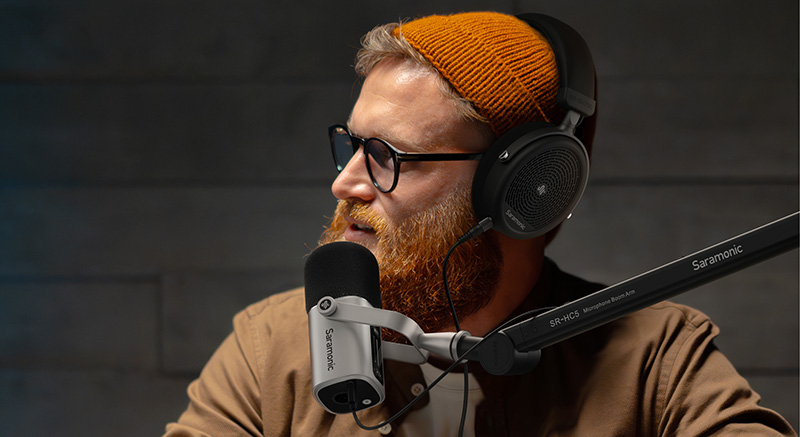In the digital age, whether you're tracking with your music, launching a podcast, streaming to an audience, or nailing a voice-over performance, your audio quality is all about it before you've even spoken. Getting that clean, clear, professional sound many times starts with the right microphone. For capturing nuance and clarity while recording, pro condenser mics are frequently the choice for studios and professional producers alike. They are sensitive instruments designed to capture sound with amazing accuracy. This guide discusses why condensers are the favorite and how to choose and use one to achieve studio-quality sound in 2025.

In contrast to dynamic mics, which utilize a suspended coil that moves (appropriate for loud sounds and live performance), condenser mics operate on a different principle. They consist of a thin, electrically conducting diaphragm stretched close to a solid metal backplate, forming a capacitor. Sound waves cause the diaphragm to oscillate, changing the distance between the diaphragm and the backplate, thereby altering the capacitance. This fluctuation of electricity is converted to an audio signal.
This layout makes condenser mics intensely sound pressure level-sensitive and also sound-sensitive to minute variations of sound. They are quite adept at catching subtle nuance, high-end frequencies (for that air and glitter), and staccato transients (the initial attack of a sound, a finger-pluck on a string, for instance). Unfortunately, this sensitivity is powered externally by phantom power in the shape of +48V from an audio interface, a mixer, or a preamp via the XLR cable. USB condenser mics conveniently draw power directly from the computer.
Choosing a condenser mic involves looking beyond the price. Having the key specs in mind enables you to match the mic to your needs:
This is the directional sensitivity of the microphone—where it picks up sound from. Common patterns include:
This indicates the range of frequencies the mic can capture (e.g., 20 Hz to 20 kHz, the human range) and how evenly it plays them back. A "flat" frequency response is when the mic captures all frequencies equally, providing accuracy. Others will have a slight boost or cut somewhere to provide it with character (e.g., a presence boost on vocals). Look at the frequency response chart if included.
This measures how accurately the mic converts sound pressure to an electrical signal. Greater sensitivity means the mic has a greater output signal for a given amount of sound level, essentially picking up quiet details. Sensitive mics also, though, pick up more ambient sounds and need to be gain-staged carefully so as not to clip the input of your interface or preamp.
This is the inherent noise the microphone's electronics produce, measured in dBA. Lower numbers are better, especially for recording quiet sources like nuanced vocals, voice-overs, or delicate acoustic instruments. A self-noise level below 15 dBA is generally considered very good for professional studio work.
This is the most powerful signal the mic will receive without distorting. When you anticipate recording very loud sources like drum overheads, guitar amps, or brass close up, you will need a mic with an extremely high Max SPL rating (i.e., 130 dB SPL or higher).

With the specs in mind, let's tailor the choice to common uses:
The majority of pro studio condenser mics utilize an XLR connection and need +48V phantom power. This DC power is low voltage and travels in the same XLR cable that the audio signal does. Make sure your audio interface, mixer, or preamp has a phantom power switch and engage it after plugging in the microphone. Failing to supply phantom power results in an XLR condenser mic not functioning at all. USB microphones get around this, getting their power straight through the USB cable, which makes them more convenient for direct-to-computer recording.
You have a wonderful condenser mic plosives ('P' and 'B' sounds) that create nasty thumps on the recording.
Condenser mics are also susceptible to vibration conducted through the mic stand. A shock mount decouples the microphone and the low-frequency rumbles induced by footsteps or bumps on the stand from being routed to the recording. Several Saramonic studio mics include one as a bundle.
A sturdy, stable mic stand is crucial for proper positioning and avoiding unwanted movement or vibrations.
Condenser mics capture everything, including room reflections. Treating your recording space with acoustic panels, bass traps, or even heavy blankets can significantly reduce unwanted echo and reverb, leading to cleaner recordings.
Experiment with distance and angle. Even slight movement of the mic greatly changes the sound. For voice, start at around 6-12 inches, bending to suit desired intimacy and room tone.

Condenser microphones with specialized features offer remarkable sensitivity and precision, making them precious assets to assist you in capturing studio-grade sound in music production, content, voice-over recording, and everything in between. Having vital parameters like polar patterns, frequency response, and self-noise, and corresponding to your specific use, you will be able to choose the appropriate mic for the job. Combination of your condenser takes audio quality and your professionalism to new heights in 2025 and beyond.